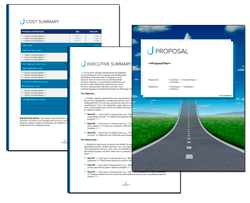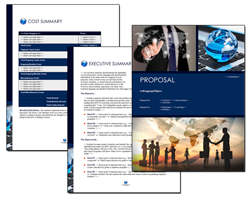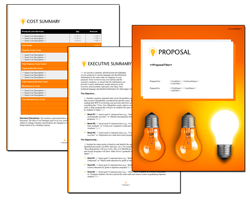
How to Write a Consulting Services Proposal: Best Practices and Tips
Winning clients with your consulting services proposal starts with understanding client needs, defining a clear project scope, and presenting a solid value proposition. This guide on writing a consulting services proposal will walk you through every step.
Key Takeaways
- A consulting proposal is an important document that outlines solutions to client challenges and sets the foundation for the client-consultant relationship.
- Thorough pre-proposal preparation, including understanding client needs and defining project scope, enhances proposal effectiveness and increases acceptance chances.
- Key components of a consulting proposal include a cover page, executive summary, project overview, and costs, all of which contribute to its professionalism.
Understanding Consulting Proposals

A consulting proposal is more than just a formal document; it's a plan outlining how to address a client's challenges and deliver solutions. It serves as a framework for the working relationship, detailing the nature of the project, the challenges faced, and how you, as a consultant, can address them. A consulting proposal secures consulting projects by summarizing solutions, and it is an indispensable tool in the consulting business.
Understanding the purpose of consulting proposals lays the foundation for creating documents that impress prospective clients.
Definition of a Consulting Proposal
A consulting proposal is a document sent to a potential client outlining how you, as a consultant, would handle a specific consulting project. Its primary purpose is to outline a plan to help clients achieve their goals by addressing their needs and challenges. This requires a thorough understanding of the client's problems and a clear, actionable value proposition that showcases the benefits they will receive.
Focus on the client's challenges and needs is essential to ensure the proposed solutions align with their requirements. Presenting a clear and actionable plan in a consulting proposal demonstrates your expertise, builds trust, and sets the stage for a successful engagement.
Importance of a Consulting Proposal
Consulting proposals are crucial for client acquisition as they provide a formal document outlining the terms of engagement. Many clients request proposals to understand the working relationship and ensure alignment on expectations. This formality helps to clarify commitments and objectives, setting a solid foundation for the client-consultant relationship.
A well-prepared consulting proposal can significantly increase the chances of closing a deal. These proposals ensure clarity during the project by outlining specific commitments and goals and help maintain a smooth working relationship.
Pre-Proposal Preparation
Before writing your consulting proposal, it's essential to prepare thoroughly. This preparation involves understanding the client's needs and goals, which is critical for creating a proposal that resonates with them. Winning proposals are customized rather than generic, addressing each client's specific challenges and objectives.
A verbal agreement from the client before submitting the proposal can help set expectations and smooth the proposal process. This section will guide you through the initial client meeting, research and analysis, and defining the project scope, all crucial steps in pre-proposal preparation.
Initial Client Meeting

The initial client meeting is your opportunity to understand the potential client's problems, wants, and needs. Establishing rapport during these meetings enhances trust and significantly increases the chances of proposal acceptance. One effective method is to send a questionnaire beforehand to gather essential details, followed by follow-up calls to ensure clarity on expectations and desired outcomes.
During the meeting, take detailed notes and list the client's specific issues and desires. This demonstrates your understanding and commitment to addressing their challenges. Building this foundation is crucial for creating a proposal that aligns with the client's goals and fosters a successful working relationship.
Research and Analysis
Tailoring your consulting proposal to each client addresses their unique needs. Thorough research is essential, including understanding the client's statistics, target audience, and competition.
If responding to an RFP, using key phrases and acronyms from the Request for Proposal (RFP) and touching on every important topic in the RFP can also demonstrate your deep understanding of their needs.
This research informs your proposal and shows the client that you are well-prepared and knowledgeable about their industry.
Defining Project Scope
Clearly defining the project scope is crucial to ensure understanding and to prevent scope creep during the project. A well-defined project scope helps manage client expectations and facilitates smoother project execution. This involves outlining the project's goals, objectives, and specific action items the proposal covers.
Setting clear boundaries and expectations from the outset ensures alignment throughout the project's duration, which is essential for maintaining a productive and successful working relationship.
Structuring Your Consulting Services Proposal
Structuring your consulting proposal correctly is critical to presenting your ideas effectively. A consulting proposal includes several essential components: a cover page, executive summary, project overview, and objectives and goals. Talk about the client and their needs first, then costs, and then your company information comes last. Knowing how to write a consulting proposal is essential to communicating your ideas.
A consulting proposal includes several essential components:
- Cover page
- Executive summary
- Project overview
- Objectives and goals
- Costs
- Capabilities and qualifications
Proposal Kit creates professional proposals using this type of layout. This section will guide you through each component, providing best practices and insights to help you create a winning proposal.
Cover Page

The cover page of your consulting proposal is the first impression your client will have, so it needs to be solid and engaging. It should include your company branding, the client's name, project title, and date. A well-designed cover page addresses the client directly, outlines your experience, and expresses confidence in your deliverability.
Executive Summary
The executive summary provides a one-page overview of the project, summarizing the client's issues and outlining how you plan to address them. The project summary section should present the client's challenges and your proposed solutions.
Using a two-column format to highlight problems and solutions can be an effective strategy. The executive summary should articulate how your approach will resolve the identified issues and add value to the client.
Project Overview
The project overview is essential as it provides a high-level summary, including the challenges, objectives, and any significant features or functionalities that will be addressed. This section should summarize the proposed project's critical goals, objectives, and unique features.
Clearly outlining the project's scope and objectives helps the client understand the overall direction and expected outcomes, which is crucial for gaining client confidence and ensuring alignment on project goals.
Objectives and Goals
Listing three to five specific objectives in the proposal helps demonstrate the project's potential value to the client. These objectives should be clear and measurable, such as profitability and growth, to show the tangible benefits the client will receive.
Combining objectives and deliverables into bullet points with strategies for each can present them clearly and concisely. Emphasizing what the client will gain from the engagement helps build trust and showcases your capability and credibility.
Detailing the Project Scope
Detailing the project scope is critical for ensuring mutual understanding and setting clear expectations. This section should include specific action items, deliverables, and a timeline with key milestones. Outlining these elements helps you and the client stay aligned and ensures the project progresses smoothly.
A comprehensive overview of the project's scope prevents misunderstandings and scope creep, facilitating a successful engagement.
Specific Action Items

The project scope should specify the tasks to be completed, detailing each step necessary to achieve the project's objectives. Breaking the project into specific action items is essential for clarity and accountability.
Representing tasks logically can help all stakeholders understand their roles and responsibilities. Using clear and concise language in the action items section helps avoid confusion and ensures everyone is on the same page.
Deliverables
Deliverables are the concrete products or services the client will receive upon project completion. Prioritize clarity and simplicity when listing deliverables.
Including details related to the project's start and end dates and critical milestones ensures mutual understanding and sets clear expectations. This clarity is crucial for maintaining a smooth and successful project execution.
Timeline and Milestones
A well-structured timeline highlights critical dates and milestones, helping to manage client expectations. This will ensure clear communication and act as a roadmap from start to finish.
Outlining key milestones and completion dates provides checkpoints for completed work, promotes accountability, and allows for partial payments tied to milestones. This structure helps keep the project on track and ensures timely progress.
Financials and Payment Terms
Clear financial terms are crucial for maintaining a professional relationship with the client. The cost section of a consulting proposal should include consulting fees, a payment portal, a down payment, and a fee structure.
Presenting the costs, including due dates, payment methods, and terms, helps manage client expectations and fosters trust. This section will guide you through the cost breakdown, payment structure, and value proposition.
Cost Breakdown
The financial breakdown should include a clear pricing structure that aligns with the project scope and budget. This section should feature a breakdown of costs and available packages to give clients clear options.
Establishing fees based on the value provided, rather than just costs, helps justify the expenses to the client. Including case studies of previous work can also demonstrate your value and justify the proposed financial breakdown.
Payment Structure

Progress payments are standard, allowing clients to pay as specific project milestones are achieved. Different payment structures can include deposits, installments, and final payments based on project milestones.
Choosing the proper payment structure depends on the project scope, client preferences, and your financial strategy. Clear payment terms help avoid misunderstandings and ensure smooth financial transactions.
Value Proposition
A strong value proposition is essential for an effective consulting proposal. Demonstrating a high return on investment can encourage clients to accept the proposal. Including expected increases in client revenue within the value proposition enhances its persuasiveness.
By clearly articulating the benefits and ROI, you can make your proposal more compelling and increase the chances of acceptance.
Legal and Contractual Terms
Including legal and contractual terms in your consulting proposal protects both parties and ensures clear expectations. This section should cover contract details, payment information, and termination terms.
Clear legal agreements safeguard the interests of both you and the client, facilitating a smooth and professional engagement.
A small consulting project may include a contract or work order in the proposal. Larger, riskier, and more complex consulting projects usually sign a separate contract after accepting the proposal. Consult your attorney to review your contracts and agreements before using them.
The Proposal Kit lets you incorporate a work order or contract into the proposal or create it as a separate document.
Terms and Conditions
The terms and conditions section outlines cancellation policies, payment terms, and independent contractor clauses. It should also define the responsibilities of both the consultant and the client.
Using clear language and avoiding jargon enhances client understanding and facilitates quicker approval. Leveraging a contract template can help ensure all necessary terms are included and presented. Contracts obtained in packages or online are licensed as self-help information, not legal advice.
Indemnities and Liabilities
Indemnity clauses are critical for managing financial risks associated with consulting agreements. These clauses protect both parties by defining the extent of liabilities and ensuring that neither party is unfairly burdened.
It's important to include clear and balanced indemnity terms to maintain fairness and protect the interests of both the consultant and the client.
Expiration Date

Setting an expiration date on your consulting proposal encourages timely decision-making from the client. Providing a clear timeframe for acceptance motivates clients to review and respond quickly, reducing the risk of the proposal becoming outdated due to changing circumstances.
This sense of urgency helps maintain the proposal's value and ensures that both parties can proceed without unnecessary delays.
Finalizing and Reviewing Your Proposal
Finalizing and reviewing your proposal is critical to ensure it is polished and professional. Thorough proofreading and editing are essential for presenting a precise and professional proposal. Consistency in presentations and formatting is crucial for creating a professional impression. Refrain from introducing new information not previously discussed, which can lead to confusion and miscommunication. Keeping the proposal concise helps accurately describe the project scope and expectations without losing the client's attention.
This section will guide you through proofreading and editing, seeking feedback, and using Proposal Kit tools to streamline the proposal process and enhance its quality.
Proofreading and Editing
Proofreading and editing ensure clarity and professionalism in consulting proposals, enhancing their effectiveness and credibility. Having fresh eyes review the proposal can uncover errors and improve clarity.
Use grammar and spell-checking tools to make your proposal more straightforward to read.
Keeping the proposal concise improves its readability and engagement. Meticulously reviewing your proposal ensures that it accurately conveys your message and leaves a positive impression on the client.
Seeking Feedback
Seeking feedback is essential in refining and enhancing the quality of a consulting proposal. Peer feedback can provide new perspectives and highlight overlooked aspects, strengthening the proposal. Proactively seeking feedback can lead to a more polished and professional final proposal.
Incorporating this feedback ensures that your proposal is well-rounded and effectively addresses all potential client's concerns.
Using Proposal Kit Tools
Proposal Kit tools can help streamline the proposal process by providing reusable templates. Proposal Kit offers templates, design themes, layouts, samples, and automation software tailored for any consulting proposal, making it the best solution for writing consulting proposals. Using these tools, you can easily create professional winning proposals, ensuring consistency and quality across all your documents.
The Proposal Kit software includes line-item database quoting features for all the financial and schedule pages, such as the Cost Summary, Estimate, Invoice, Budget, Project Schedule, and more.
These resources save time and enhance the overall presentation of your consulting proposals.
Here are some related samples included in every downloadable Proposal Pack
The AI Writer generates a first draft of these templates - customized to your company, client, and project - in just minutes, giving you a head start on editing. Get any Proposal Pack or Proposal Kit Professional, and all of these samples, and the AI Writer are included.
- Business Services and Consulting Sample Proposal
- Technology Consulting Sample Proposal
- Company Rebranding Sample Proposal
- Process Improvement Sample Proposal
- Energy Efficiency Sample Proposal
- Temp Agency Services Sample Proposal
- Business Continuity Services Sample Proposal
- Manufacturing Process Improvement Sample Proposal
- Business Growth Services Sample Proposal
Here are some related downloadable templates
The AI Writer generates a first draft of these templates - customized to your company, client, and project - in just minutes, giving you a head start on editing. Get any Proposal Pack or Proposal Kit Professional, and all of these templates and the AI Writer are included.
- Business Consulting Proposal Template
- Business Services and Consulting Proposal
- Cloud Services Consulting Proposal
- Consulting Agreement Proposal Template
- Consulting Proposal Template
- Consulting Services Proposal
- Consulting Services RFP Response Proposal Template
- Healthcare Consultant Project Proposal
- Political Lobbying and Consulting Services Proposal
- Project Management Consulting Services Proposal
- Technology Consulting Proposal
- Consultant Fee Schedule Proposal Template
- Consultant Proposal Template
Submitting the Proposal
Submitting your consulting proposal is a formal step that should follow a sales conversation and a verbal agreement from the client. Following submission guidelines is essential for clarity and professionalism.
Presentation Tips
Presenting your consulting proposal professionally is crucial for building credibility and trust with potential clients. If the client has questions or concerns about the proposal, be open, honest, and transparent about deliverables. Address any concerns promptly to clarify the relationship and ensure that both parties are on the same page.
Professional presentation and clear communication can significantly enhance your proposal's acceptance.
Follow-Up Strategies

Following up shortly after submission shows continued interest and engagement. Regularly checking in with clients can build relationships and clarify any uncertainties regarding the proposal. Clarifying any questions during follow-up can resolve uncertainties and maintain momentum.
Effective follow-up can reinforce the proposal's key points and ensure the client remains engaged and interested in your services.
Summary
Creating a consulting proposal involves well-defined steps, from understanding the client's needs to presenting a polished and professional document. Following the best practices outlined in this guide can increase your chances of securing projects and building successful client relationships. Remember to focus on clarity, professionalism, and alignment with the client's goals at every stage of the proposal process.
In conclusion, a well-written consulting proposal is a powerful tool for setting yourself apart from the competition. By applying the tips and strategies discussed, you can create proposals that win clients and establish a strong foundation for successful engagements.
 Proposal Kit Professional provides the most content, including legal contracts and a free design theme pack. Plus, advanced software features include custom branding and customizable quoting databases.
Proposal Kit Professional provides the most content, including legal contracts and a free design theme pack. Plus, advanced software features include custom branding and customizable quoting databases. Proposal Pack for Any Business covers this type of proposal and includes samples. There are also some commonly used specialty design themes available:
Proposal Pack for Any Business covers this type of proposal and includes samples. There are also some commonly used specialty design themes available:Photo Design Proposal Packs
 Proposal Pack Bullseye #3
Proposal Pack Bullseye #3 Proposal Pack Business #20
Proposal Pack Business #20 Proposal Pack Business #23
Proposal Pack Business #23 Proposal Pack Classic #18
Proposal Pack Classic #18 Proposal Pack Classic #21
Proposal Pack Classic #21 Proposal Pack Communication #4
Proposal Pack Communication #4 Proposal Pack Concepts #16
Proposal Pack Concepts #16 Proposal Pack Contemporary #21
Proposal Pack Contemporary #21 Proposal Pack Global #4
Proposal Pack Global #4 Proposal Pack Marketing #2
Proposal Pack Marketing #2 Proposal Pack Symbols #11
Proposal Pack Symbols #11 Proposal Pack Symbols #8
Proposal Pack Symbols #8
Frequently Asked Questions
What is a consulting proposal?
A consulting proposal is a document that details how a consultant plans to address a client's specific project by outlining solutions tailored to their needs and challenges. It serves as a roadmap for collaboration between the consultant and the client.
Why are consulting proposals important?
Consulting proposals are crucial for client acquisition. They clearly outline the terms of engagement, align expectations, and establish a strong foundation for the client-consultant relationship. This clarity fosters trust and enhances the likelihood of successful collaboration.
What should be included in the project scope section of a consulting proposal?
The project scope section must clearly define specific action items, deliverables, and a timeline with key milestones to establish mutual understanding and set clear expectations. This clarity is essential for the successful execution of the project.
How do you ensure clarity and professionalism in a consulting proposal?
To ensure clarity and professionalism in a consulting proposal, focus on thorough proofreading, consistent formatting, and refraining from introducing new information not previously discussed. This approach will enhance the overall quality and effectiveness of your proposal.
What follow-up strategies should be used after submitting a proposal?
Following up shortly after submission is essential to demonstrate continued interest and foster relationships. Regular check-ins help clarify uncertainties and reinforce key points of the proposal.



 Cart
Cart
 Are you just looking for a template, sample, or software for your consulting proposals? Click these links to skip down the page and get right to it.
Are you just looking for a template, sample, or software for your consulting proposals? Click these links to skip down the page and get right to it.

 Facebook
Facebook YouTube
YouTube Bluesky
Bluesky Search Site
Search Site